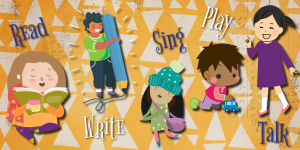
There is a magical tool that helps build your child’s brain and you can use it anywhere at any time, it is free, and you already have it. Can you guess? It is your voice. Talking with your child is one of the best ways to help them develop language and the foundations for reading and writing. It is important, however, we do not just talk at our children. Back-and-forth conversations, also called “Serve and Return,” reinforces understanding, models communication, and keeps children’s attention.
The basics of Serve and Return are simple:
- Pay attention to your child. Once they show you they are interested in something (eye contact, pointing, etc.), turn your attention to that thing.
- Show your child that you see that item and name it. “I see! That is a furry dog!” If it is something safe to touch, bring it to your child to investigate.
- This is the most important step – Wait. Give your child time to respond.
- Keep engaging back and forth with your child until they are ready to stop. That’s it!
These positive interactions are a free and simple way to help your child develop early literacy and life skills. Plus, you can do them anywhere! Here are some suggestions to get you started:

Babies
- Start now! From birth, your child is absorbing information from listening to your voice and watching your expressions. Babies’ brains are primed for speech.
- Naming your child’s gestures is an excellent way to help children begin to tie their actions to words. For example, try “You are waving your arms around!”
- As babies babble, they will start to incorporate the sounds in the words they hear. Talk to them even though they cannot form words yet.
Toddlers
- Build your child’s vocabulary by using varied words. For example, try “Wow, the train track you built is curvy and steep!”
- Young children need more time to figure out what they want and how to express it. Help your child by pausing and giving them time to respond.
- Repeat what your child says back to them. If they mispronounce or use a word incorrectly, simply repeat their question/statement with the correct usage. For example, Child: “I wanting hat.” Adult: “You want the hat?”
Preschoolers
- Ask open-ended questions “That’s interesting. Tell me more.” Don’t let “because” be an answer.
- After reading a story, ask your child to retell the story. This reinforces learning and comprehension.
- Play games with your child that require listening and following directions.
A Note about Communication
It is important to note that not all people communicate the same way. If your child uses an assistive device, sign language, or other mode of communication, there are many ways to engage and communicate with them.
-Taylor, Children's Librarian at Quincie Douglas Library
 Read, Write, Talk, Sing, Play!
Read, Write, Talk, Sing, Play!
The day children are born, their brains are primed for language. Talking with your child about anything and everything helps them build oral language skills, which are critical to early literacy!
Read more about early literacy and how you can make a difference in your child's life.

